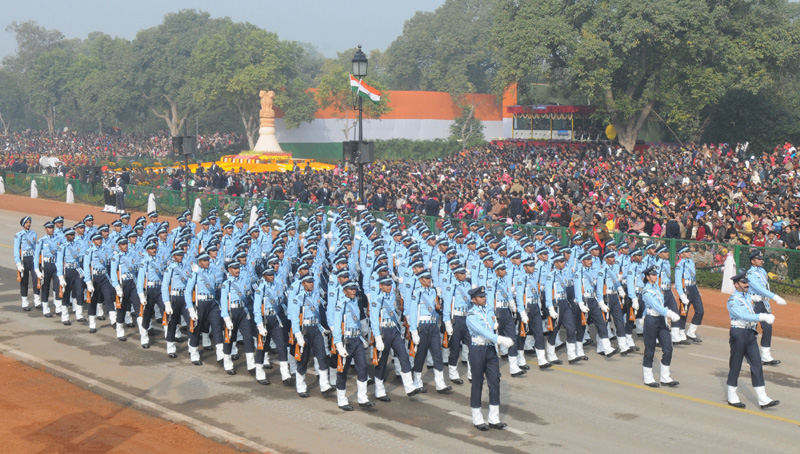 Growth forecast for Next Fiscal to remain between 5.4 to 5.9 per cent.
Growth forecast for Next Fiscal to remain between 5.4 to 5.9 per cent.Improvements in Current Account and Fiscal deficits to spur higher growth in 2014-15
A record food grains production of over 264 million tonnes is estimated in 2013-14 indicating an increase of 20 million tonnes in last 5 years
Indian economy is likely to grow in the range of 5.4 to 5.9 per cent in 2014-15 overcoming the sub-5 per cent growth of Gross Domestic Product (GDP) witnessed over the last two years. The growth slowdown in the last two years was broad based, affecting in particular the industry sector. Inflation too declined during this period, but continued to be above the comfort zone, owing primarily to the elevated level of food inflation. The Economic Survey 2014-15, presented by the Finance Minister Shri Arun Jaitley in the Lok Sabha predicts that moderation in inflation would ease the monetary policy stance and revive the confidence of investors, and with the global economy expected to recover moderately, particularly on account of performance in some advanced economies, the economy can look forward to better growth prospects in 2014-15 and beyond.
The survey also points out at the downside risks to the economy arising from a poor monsoon, the external environment and the poor investment climate. After recovering in 2009-10 and 2010-11 from the crisis and growth slowdown of 2008-09, GDP growth slowed to below 5 per cent for two consecutive years, i.e. 2012-13 and 2013-14.
The survey notes that external sector witnessed a remarkable turnaround after the first quarter of 2013-14 and the year ended with a Current Account Deficit of 1.7 per cent of GDP as against 4.7 per cent in 2012-13. Improvement is also observed on the fiscal front, with the fiscal deficit declining from 5.7 per cent of GDP in 2011-12 to 4.9 per cent in 2012-13 and 4.5 per cent in 2013-14. Aided by a favourable monsoon, the agriculture and allied sectors achieved a growth of 4.7 per cent in 2013-14 compared to its long term average of around 3 per cent (between 1999-2000 and 2012-13). A record food grains production of 264.4 million tonnes is estimated in 2013-14, as per the third Advance Estimates, indicating an increase of more than 20 million tonnes over the average production during the previous five years. Horticulture production is estimated at 265 million tonnes in 2012-13 and for the first time has exceeded the production of food grains and oilseeds. The robustness of the agriculture and allied sector can be attributed to the steady increase in gross capital formation (GCF) in this sector. In industry, the contraction in mining and quarrying for the second year in a row in 2013-14 and the negligible growth in manufacturing over the past two years, indicate the severity of structural bottlenecks. A slowdown is also noticed in services, in particular the internal trade, transport, and storage sectors that are largely attributed to the loss of momentum in commodity-producing sectors, especially, the industry sector. Thus, the revival of the industrial sector, with its economy-wide linkages, is central to the revival of aggregate economic activity.
Referring to the demographic dividend, the survey states that India with a large and young population has a great demographic advantage. The proportion of working-age population is likely to increase from approximately 58 per cent in 2001 to more than 64 per cent 2021. While this provides opportunities, it also poses challenges. Policy makers have to design and execute development strategies that target this large young population.
Demographic advantage is unlikely to last indefinitely. Therefore timely action to make people healthy, educated and adequately skilled is of paramount importance.
The survey points out that the priority of the Government will be the revival of business sentiments that could be at the heart of restarting the investment cycle. Aggregate demand (measured in terms of GDP at market prices) registered a growth of 5.0 per cent in 2013-14 vis-à-vis 4.7 per cent in 2012-13 primarily due to improvement in net exports. The decline in the rate of gross fixed capital formation in 2013-14 reflects subdued business sentiments.
The investment boom in India till 2007-08 was largely due to significant increase in investment by the private corporate sector. The steep reduction in the rate of private corporate investment, leading to slowdown in overall investment rate in the economy, in recent years, point towards the need for revival of business sentiments. The survey adds that developments like the dramatic improvement in the external economic situation with the current account deficit declining to manageable levels and reduction in the fiscal deficit in 2013-14, along with some moderation in inflation, augur well for macroeconomic stabilization and revival of business confidence and investment.
In the above context, apart from fiscal consolidation, maintaining a stable external balance and further control of inflation, priorities for growth revival include streamlining implementation procedures to restart the investment cycle; simplification of tax policy, repeal of archaic laws governing market access, expansion and entry/exit of firms and revamp of the dispute resolution mechanism for commercial disputes to lend greater predictability to policy; boost to physical infrastructure; and, reforms that enhance productivity in agriculture, etc. are crucial.
Targeted measures by the government and RBI have improved the external economic situation significantly, even as India remains exposed to risk on/off sentiments of investors and to policy shifts in advanced economies. Regaining growth momentum requires restoration of domestic macroeconomic balance and enhancing efficiency. To this end, the emphasis of policy would have to remain on fiscal consolidation and removal of structural constraints. Though some measures have been initiated to this end, reversion to a growth rate of around 7-8 per cent can only occur beyond the ongoing and the next fiscal.
